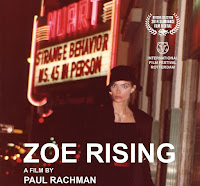Text © Richard Gary / Indie Horror Films, 2020
Images from the Internet
A Drunk Scorpion Will
Sting Itself to Death
Directed by Denton True
A Hard Work and True Storys Production
76 minutes, 2029
My home town of Brooklyn
is represented in Denton True’s sophomore film, though honestly, it’s not a
Brooklyn I recognize from the middle class Bensonhurst from which I come. The
title of the film may sound like an Italian giallo film from the 1980s,
but it is solid local drug denizen territory.
As with his first
film, American Male (2018), which I have not seen, True both directs and
stars as its main character; in this new one, he’s Dean, a drug addict who is
trying to get himself clean. Note that he was played a junkie in the first
film, so there seems to be a motif going on here.
 |
| Denton True |
Hanging out with his crew
on a rooftop along Broadway in Williamsburg near the EL (you can see the old domed
Williamsburg Savings Bank on Driggs in the background), including somewhat
girlfriend Diana (Eva Maria Wojcik), and getting higher than the building elevation,
he ODs and falls off the roof, breaking his nose, and with a prominent black eye.
This isn’t a band of brothers (and sisters), they are bonded by what they
smoke, which is a tenuous and untrusting connection at best.
Through a
confrontation on a train, he meets Maria (Chanel Mack), dressed in red as she is
one of right-wing Curtis Sliwa’s group of subway vigilantes, The Guardian
Angels. It’s appropriate as its apparent there will be some sort of
relationship between them as he tries to get straight, becoming his personal
guardian angel in more ways than one.
Perhaps it’s real
life, but there is an extremely liberal use of the word “Fuck” throughout the
entire run time. I’m not offended by the word in any way, but eventually it
starts to become distracting, and the dialog gets lost in it. As a metaphor, remember
when Rocky was fighting the Russian dude, and he just kept wailing away at one
spot until the bigger and stronger guy starts to wince? It’s kind of like that.
It’s not the word itself, but the constant contextualizing of it. Eventually,
it’s all you hear, and the dialog gets lost in the flood of any one word or
expression, such as “like,” “y’know” or “dude”; I actually heard someone say “Dude,
this dude doesn’t know, dude,” on the streets of Berlin.
 |
| Chanel Mack |
There are some
interesting twists and turns here that make this more than just a “get-straight”
narrative, and brings it right back to the American giallo. The thing I
know about getting clean, even being straight-edged, is that one of the hardest
things to getting free of drugs (and alcohol) is the friends you keep. Part of
any 12 Step Program is to stay away from those who use. Well, thanks to Maria,
Dean finds a more permanent way to do that, that is actually pretty hardcore
for what you may be expecting for this kind of film.
While the relationship
between Dean and Maria is hazy other than sponsor and roommates, it is clear
there is some twisted version of caring between Dean and Diana, who has a
different vision of her future, much like The Days of Wine and Roses (1962),
where one partner wants to get out and the other doesn’t. But can Dean actually
do it? He definitely shows some ambivalence, but this is more a destitute lifestyle
paradigm shift rather than just paying to go to rehab, which is new and
different from Dean’s life up to that point and has been for at least a decade.
Brooklyn, for this
story, is not exactly shown in the best light, with littered, wet streets, that
is more reminiscent of Taxi Driver (1976) than the glorification of the city
in, say, They Might Be Giants (1971). But considering the texture and
tone of the film and it’s subject matter, it is quite appropriate.
The sound quality,
like Dean’s thought processes, can be a bit chaotic. As there is an attempt
towards clarity, the dialog is often matched with dogs barking, people talking,
being on the subway, or just street noise as many scenes take us along walks among
Brooklyn’s streets. The soundtrack is as muddled as Dean’s brain trying to
function.
True’s filmmaking
style is reminiscent of John Cassavetes (d. 1989), with a nearly documentary
style, lots of close-ups, and a tendency to go in and out of focus momentarily
here and there. But this style works well both for the story, for the
characters, and for Dean’s thought processes. The big mystery is if can he
succeed with so much violence in his wake.




















